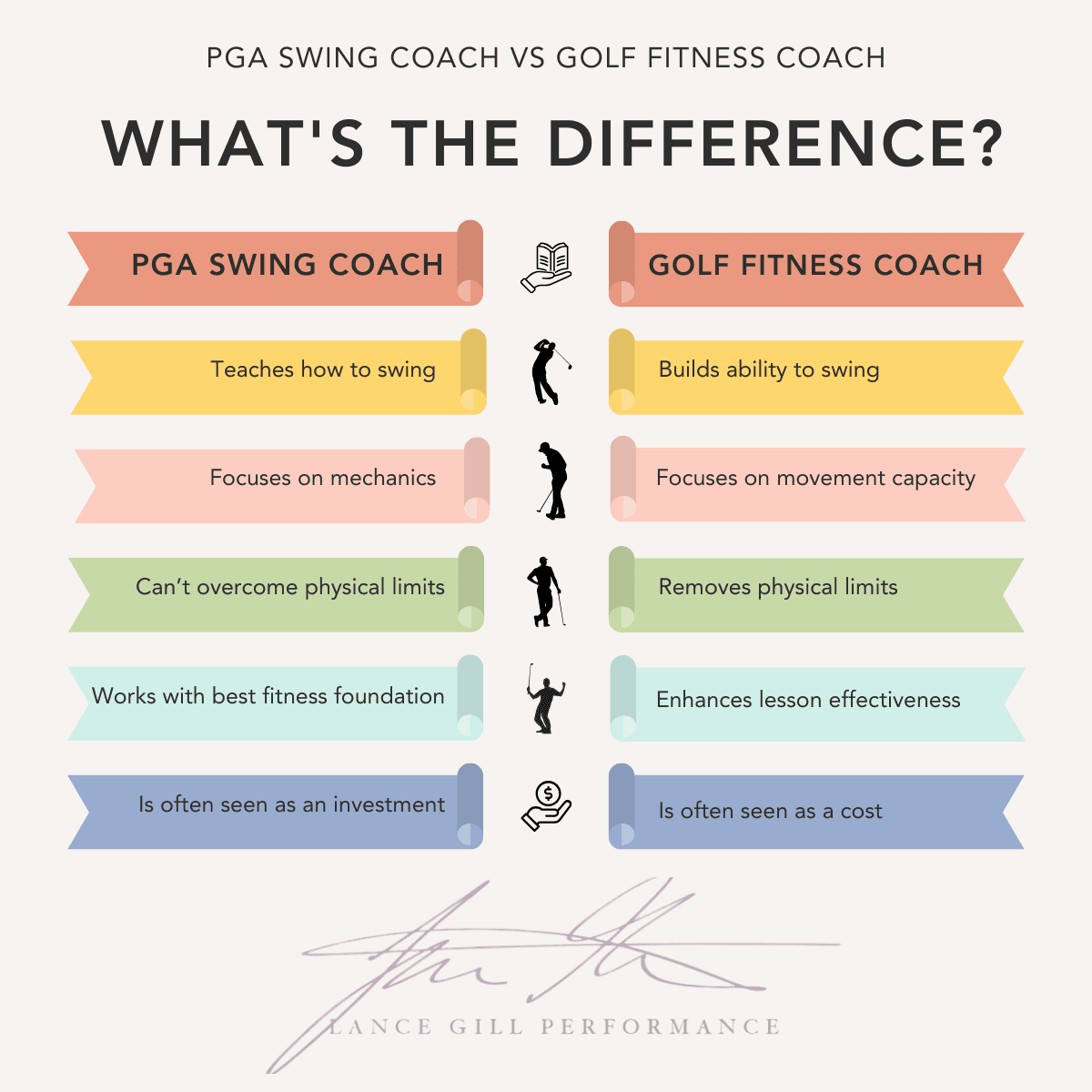WHAT IS GOLF FITNESS?
When most people hear the words "Golf Fitness", they look at you like you are crazy. That is because most people see golf as a leisure sport. But in reality, the modern golf swing is one of the most explosive and complex athletic movements in all of sports.

Golf Fitness Should Support Your Golf Swing
An average 18-hole round equals 11,000+ steps and over 360–400 rotational swings per week for regular players. That’s a serious athletic workload! Often, it is repeated week after week by bodies that haven’t been trained for it.
The result for many golfers is: Sore backs. Inconsistent swings. Shorter drives. Frustration.
That’s where golf fitness comes in. It’s not bodybuilding and it’s not random stretching. Golf fitness is a specific discipline designed to help you move, rotate, and generate power the way the golf swing demands — while keeping your body healthy and preventing injury for decades.
What Does Golf Fitness Training look like?
Golf fitness is the systematic development of mobility, stability, strength, and power — four physical pillars that directly affect every aspect of your swing.
The Four Pillars to be Fit for Golf
Mobility – The ability to move your body into efficient swing positions.
Focus areas: hips, shoulders, thoracic spine. Without mobility, the swing becomes restricted and inconsistent.
Stability – The control to maintain posture through rotation.
Prevents compensations like early extension and loss of balance.
Strength – The capacity to produce and control force throughout the swing.
Builds distance, endurance, and consistency across 18 holes.
Power – The ability to transfer energy explosively from the ground through the clubhead.Power depends on the foundation of the first three pillars.
PGA Exercise vs. Traditional Gym Training
Traditional workouts isolate muscles (bench press, curls, machines).
Golf fitness builds functional, rotational strength that mimics the athletic demands of the swing — using multi-planar, balance-driven movements.
Traditional workouts: static, linear, appearance-focused.
Golf Training Program: dynamic, rotational, performance-focused.
Example:
A chest press builds muscle in a fixed position.
A golfer’s cable press, by contrast, strengthens the chest while maintaining golf posture and core control.
Golf Swing Mechanics vs. Biomechanics
The Kinetic Chain: How Power Transfers Through the Body
Every swing 'should be' a coordinated chain reaction — from your feet → legs → hips → torso → shoulders → arms → club. If any link is weak or immobile, energy leaks occur, reducing both distance and control.
As it has been said: "A chain is no stronger than its weakest link".

The ideal system for a powerful golf swing is both together. The top fitness plans are full body that prepares you for what instruction demands. When your coach says “rotate more,” your body can finally do it safely and powerfully.
Common Questions (and if it really helps your golf game)
1. Is weight training bad for golf?
No. When programmed correctly, strength training increases mobility.
Full-range strength work matches or exceeds flexibility gains from stretching alone.
Muscle strength built with med ball slams can also increase stamina.
2. Am I too old for a workout program?
Absolutely not. The older the golfer, the greater the return.
Resistance and balance training maintain mobility, stability, and bone density.
3. Do I need to mimic my swing in the gym?
No — that can actually confuse your movement patterns.
Train fundamental patterns (squat, hinge, lunge, push, pull) that translate naturally.
4. How long should a workout plan be?
On average 2–3 sessions per week, 30 minutes each, can transform your game within 7-10 days.
5. Will it lower my handicap?
Yes — by removing physical barriers your range of motion will increase.
Physical qualities like stronger glutes and hamstrings improve driving distance.
6. What about seniors?
Golf fitness is essential for players 60+.
To Play better you need a full range of motion and you need to optimize balance and coordination. Exercises like targeted Hip and T-spine wellness reduce pain, increase overall health, improve your game and translate to better performance.
General Health on the Golf Course is...
Not bodybuilding – It’s functional, athletic strength, not bulk.
Not just stretching – Mobility is one phase; stability, strength, and power follow.
Not one-size-fits-all – Programs must match your assessment and limitations.
Not gym-dependent – Bands, bodyweight, and kettlebells can do the job anywhere.
Not only for pros – Recreational and senior golfers often benefit the most.
The 4 Key Components of an Effective Golf Fitness Program

1. Establish your Goals
Understanding the direction you golf journey will take depends upon knowing the goals and milestones you want to achieve. The basis of your entire golfing journey will hinge around these essential focal points.
2. Movement Screening & Assessment
Identify lower body and upper body physical limitations.
Key tests: hip internal rotation, T-spine rotation, shoulder mobility, single-leg balance.
(Tip: Get a TPI or professional screen.)
3. Focused Training For Golf
Phase 1: Mobility (Weeks 1–2)
Phase 2: Stability (Weeks 3–4)
Phase 3: Strength (Weeks 5–8)
Phase 4: Power (Weeks 9+)
Example moves: bird dogs, glute bridges, squats, woodchops, med-ball throws.
4. Restoring Human Movement with Expert Coaching Feedback
Form Checks done at frequent intervals to assure efficient and functional movement.
Rotational drills: half-kneeling thoracic rotations, 90/90 hip stretches.
Frequency: 2–3× weekly and distance has increased along with clubhead speed.
Actual Golf Performance Benefits Beyond the Gym
Distance: +10–11% in 8 weeks.
+6.3% club head speed increase
Consistency: Less swing variability.
Injury Prevention: 33–50% reduction.
Health: Improved cardiovascular, metabolic, and bone health.
Longevity: Golfers live ~5 years longer.
Confidence: Physical readiness builds mental resilience.
How To Transform Your Golf

Understand Your Golf Goals – Distance, pain-free rounds, longevity, handicap, consistency etc.
Get Assessed – Allow a certified golf fitness professional to identify physical limitations.
Customized Training – 3 personalized sessions 30–45 min/per week will build proper fitness foundations.
Be Consistent – Treat sessions like tee times.
Integrate – Warm-ups, off-season training, and in-season maintenance.
Trust Your Performance Coach – Make sure you understand how your training supports your golf swing.
Conclusion
Golf fitness isn’t a buzzword — it’s the foundation of modern performance.
By training the body behind the swing, you unlock more distance, control, and confidence — all while protecting your joints and extending your playing life.
The best players in the world treat their bodies like their most important equipment!
👉 Next Step: Free Strategy Call Discover your unique strengths and limitations with a personalized golf fitness assessment and start freeing your swing today.